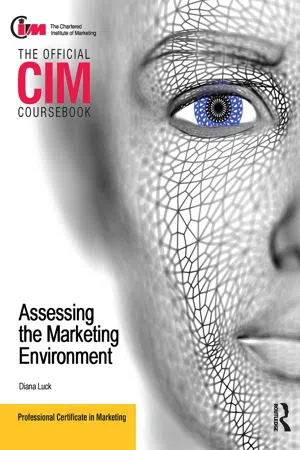External Environment
The external environment refers to the factors, forces, and conditions outside a business that can impact its operations and performance. These may include economic conditions, technological advancements, political and legal regulations, social and cultural trends, and competitive forces. Understanding and adapting to changes in the external environment is crucial for businesses to remain competitive and sustainable.
8 Key excerpts on "External Environment"
- eBook - ePub
- Barry Witcher(Author)
- 2019(Publication Date)
- Routledge(Publisher)
...3 The External Environment Essential summary The External Environment is those conditions external to the organization which influence the organization and its industry, especially those that influence the intensity of competition. The PESTEL framework is a broad but useful mnemonic to group External Environmental influences into political, economic, social, technological, environmental, and legal factors. Structural breaks are fundamental and unpredictable events in the External Environment which are likely to require a sudden rethinking about an organization’s purpose and strategy. The industry life cycle likens the life of an industry to a living organism that goes through stages of introduction, growth, maturity, and decline; each stage exhibits distinct characteristics that should be considered against the purpose of the organization. The five competitive forces are the primary influences affecting choice of industry and competitive positioning, which affect an organization’s competitive advantage and profitability. Hypercompetition is a dynamic state of constant disequilibrium and competitive change in an industry. An organization’s External Environment consists of the conditions outside the organization, including the people and organizations that influence the external changes in the organization’s industry, especially those that influence the intensity of competition. External conditions are constantly changing, and organizations need to monitor and review strategy continuously to effectively manage any emerging threats and to be able to exploit advantageous opportunities. Many changes are difficult to identify, and their consequences are often uncertain and even unknowable...
- Triant G. Flouris, Sharon L. Oswald(Authors)
- 2016(Publication Date)
- Routledge(Publisher)
...While one company cannot have a major effect on these forces, changes in External Environmental forces can have a significant effect on the way the company does business. In other words, a company could be forced to change its business model or strategic direction based solely on a change in one of these relevant forces. Furthermore, just as there is a micro and macro analysis in economics, a company is affected by both macro and micro-environmental forces. The Macro External Environment The macro External Environment consists of such things as the economy, unemployment levels, inflation, the demographics of the population, governmental legislation and regulations, political power and stability, technology and even the values and lifestyles of the society at large. The macro environment is shown in Figure 4.1. A manager might think that these environmental forces are well beyond the scope of the company’s influence; however, failure to keep a close watch on these forces could cause an airline to be ill-prepared for the future. Figure 4.1 The Macro External Environment Let us begin our examination of the macro External Environment with the economy. During times of economic prosperity, as was the case during the late 1990s, people have more disposable income. It is during these times when one might see an increase in leisure time activities, such as family vacations and weekend getaways. Economic prosperity means good times for airline-related companies. Conversely, airlines and related businesses suffer greatly during downturns in the economy because disposable income is less prevalent and the general public tends to stay closer to home. It is at times like these that the business traveler, rather than the leisure traveler, becomes the focus for many airlines. Unemployment is another macro environmental factor. During times of full employment, the labor market is a seller’s market...
- eBook - ePub
Strategic Management
Theory and Practice
- John A. Parnell(Author)
- 2013(Publication Date)
- SAGE Publications, Inc(Publisher)
...Chapter Outline Analysis of the External Environment Political-Legal Forces Global Considerations Economic Forces Gross Domestic Product Inflation Rates Interest Rates Exchange Rates Ecological Influences Summary Key Terms Review Questions and Exercises Practice Quiz Student Study Site Notes chapter 3 The External Environment Political-Legal and Economic Forces A fter the industry has been clearly defined and its potential profitability assessed, forces outside the industry should be considered. Constant changes in these external forces can present numerous challenges to strategic managers. It is important to understand how these forces collectively influence the industry in which a firm competes before strategic plans are developed. Although a number of individual companies are discussed, this chapter continues with an industrial organization (IO) perspective by emphasizing effects on entire industries, not just firms. Analysis of the External Environment ____________ Organizations and industries exist within a complex network of external forces. Together, these elements comprise the External Environment, or macroenvironment. There are four categories of macroenvironmental forces: (1) political-legal, (2) economic, (3) social, and (4) technological (see Figure 3.1). The analysis of external factors may be referenced as PEST —political-legal, economic, social, and technological—an acronym derived from the first letter of each of the four categories of forces. The effects of External Environmental forces on a firm’s industry should be well understood before strategic options are evaluated. Political-legal and economic forces are addressed in this chapter. Social and technological forces are addressed in the next chapter. Firms operating in multiple, distinct geographical markets may be affected in different manners by external forces in each market...
- eBook - ePub
My Start-Up Plan
The business plan toolkit
- Clare Griffiths, Brad Crescenzo(Authors)
- 2012(Publication Date)
- Harriman House(Publisher)
...Changes to the environment can also shape consumer behaviour, as more people become increasingly environmentally conscious with a greater desire to buy locally and ethically. As more consumers favour environmentally-friendly products and services, new markets will be created, and other markets will diminish. Business will also be expected to operate in a ‘greener’ manner, and therefore may have to change certain processes and the way in which they communicate with consumers. Which environmental factors are most likely to change? Which of these will have greatest impact on your business? Do they represent opportunities or threats to you and your business? Environmental factors such as. . .. . . . . .. . . . . .. . . . . . What can you do to prepare or respond to these potential changing factors? I can. . .. . . . . .. . . . . .. . . . . . Summary You may feel that it is overly dramatic to consider how the External Environment will affect your business. However, whatever the size of your venture – whether you are a sole trader or a company with a team of partners or employees – the external factors outlined in this chapter can impact on your business. Whilst you may not be able to respond to all these factors, it is worthwhile identifying what opportunities or threats arise out of them. That way you can prepare your business to react to the best of its ability. Some changes in the External Environment in which you operate will be predictable; others will be unexpected. Your aim, therefore, should be to build a business which can operate flexibly. Information about your External Environment can go into the Opportunity Analysis section of your business plan template if you choose to write a formal plan....
- eBook - ePub
- Alasdair Blair, David Hitchcock(Authors)
- 2004(Publication Date)
- Routledge(Publisher)
...1: Environment and business: the nature of the relationships The basic elements—business, environment and environmentalism Impact of business on the environment The environment influencing business Business cultures and ethics The globalization of business Environmental and political standpoints Simple answers rarely suffice for complex problems; environmental and natural resources problems are not an exception. (Tom Tietenberg, 2000) The environment is in the process of becoming a major new competitive area for business. Understanding the impact of the relevant issues and responding to the resulting opportunities and threats will become an important source of competitive advantage. (Elkington and Burke, 1987) One of the main aims of this first chapter is to familiarize the reader with the relationships which are to be explored in this book. The relationships in themselves are relatively straightforward. First, business activities have an impact on the environment. This occurs through pollution, the modification of ecosystems, introducing exotic species and chemical compounds, genetic engineering and irreversible physical changes—the sorts of impacts widely reported in the popular press and television. The ways in which land has been used, particularly for agriculture and forestry, are a reflection of the way in which the commercial pressures of business have changed the physical landscape. Business affects the environment in a variety of ways both deliberate and accidental. Most of the effects are usually seen as detrimental, although increasingly we see some business activity improving the environment. For example, a number of museums and country houses have been opened to the public where the restoration of former days of glory have halted decades of decline and reinstated previous, albeit not entirely natural, surroundings...
- Diana Luck(Author)
- 2010(Publication Date)
- Routledge(Publisher)
...CHAPTER 2 The External Environment and Stakeholders Learning Outcomes Scope and complexity of the marketing environment. The significance of shareholders and various stakeholders to the marketing process. Classification of external challenges and influences. STUDY TIP This chapter introduces the marketing environment, considers the nature and importance of environmental change and identifies some implications for marketing strategy and planning. The micro-environment may be defined as including the groups and organisations that have a two-way operational relationship with the business, and which are controlled and influenced by it to some degree. This environment is the work-a-day operational context for the organisation. We saw in Chapter 1 that the organisation is an open system with boundaries to its immediate environment. Relationships must be established across these boundaries if supplies or credit, for example, are to be obtained. Similarly, the organisation must have effective linkages, through intermediaries, to the marketplace, or directly to the final customers themselves. Competitors also inhabit this environment and the marketer must understand the significance of relationships that prevail within the industry setting. This will be discussed in depth in Chapter 3. Information is critical to understanding and the marketer must draw on a network of intelligence sources, if successful change is to be made. The organisation must be proactive if it is to control or at least influence the behaviour of the various stakeholders and pressure groups to be found in the micro-environment. This syllabus area relates directly to your own experience. You are a consumer within the market environment. You supply labour for your employer. You are aware of the competitors operating in your industry. You may deal with distributors or consumers. Marketing promotes profitable relationships across boundaries...
- eBook - ePub
Social Entrepreneurship
Managing the Creation of Social Value
- Constant Beugré(Author)
- 2016(Publication Date)
- Routledge(Publisher)
...With this understanding, students are equipped to assess the role of the External Environment on social venture creation, which is discussed in the second section. This section uses the institutional environment of entrepreneurship and the PEST model as conceptual frameworks to explain how environmental forces shape social entrepreneurial activity in a given country. The final section discusses the traditional strategic management tools that can be used to analyze the External Environment of social ventures. 1 Understanding the External Environment of Entrepreneurship 1.1 The Macro-Environment of Entrepreneurship Context is important in understanding entrepreneurship. 1 It determines when, how, and why entrepreneurship happens; it can be an asset or a liability that shapes entrepreneurship; but, equally, entrepreneurship may influence context, too. 2 Entrepreneurs can bring about social change by being engaged and working with the community in which they are embedded. 3 Viewed from this angle, entrepreneurship could be construed as a socially embedded process. 4 The social problems prevailing in a particular country may influence the likelihood of creating social ventures to address them. For example, Safeena Husain created Educate Girls (www.educategirls.in) in 2007 to address the issue of girls’ education in rural India, which is a significant problem there and in other developing and emerging areas. Such a venture would not be created in the United States or Western Europe, where girls’ education is not an endemic social problem. As the saying goes, no man is an island. This adage could be extended to entrepreneurship by arguing that no entrepreneur is an island and surely no firm is an island. The implication of this saying is that entrepreneurs and the firms they create always operate in environments that shape them...
- eBook - ePub
- Rob Dransfield(Author)
- 2013(Publication Date)
- Routledge(Publisher)
...6 Business strategy in an economic context Chapter Outline 6.1 Introduction 6.2 What business strategy involves 6.3 The ingredients of strategy 6.4 The criteria for an effective strategy 6.5 How an environmental analysis helps to determine the suitability of a strategy 6.6 The nature of strategic vision, objectives, focus and architecture 6.7 Business strategy in an economic context 6.8 Summary Chapter Objectives By the end of this chapter you will understand : Why businesses need to have an effective strategy The components that need to be in place to create a business strategy How to judge a strategy in terms of suitability, acceptability and feasibility How to create a PEST analysis Why it is important to evaluate the economic environment and its impact on business strategy 6.1 Introduction Businesses need to have a sense of the direction in which they want to move. Once they are clear about this they can formulate their plans – strategies to achieve their desired goals. However, the process is not as simple as it sounds. Businesses operate in uncertain environments. They need therefore to be continually prepared to adjust their strategies to accommodate for environmental change. Perhaps the biggest uncertainty in the business environment is economic change. This is one of the reasons why an understanding of economics is so important to business students. You need to be able to understand the impact of major macro-economic changes such as changes in the gross domestic product (GDP) of a country, and the relative growth of different economies. This chapter therefore explores corporate strategy in the context of an uncertain economic environment...







